Cocobolo |
Dalbergia RetusaRanging from bright orange to deep reds and dark purple. Beautiful color and grain, fine texture.
Cocobolo Rosewood (Dalbergia Retusa)
is one of the finest and most beautifully figured woods in the world. True
Rosewoods in the Dalbergia family have colors as widely diverse as a rainbow.
An incredibly figured wood, cocobolo is very hard with brilliant colors and
amazing black stripes. Oranges, reds, browns and blacks all swirled uniquely
together are a trademark of this fantastic wood. The best cocobolo comes from
Central America
Quicksilver
Guitars Are Awesome
Quicksilver In Cocobolo With Macassar Ebony Neck
Cocobolo Top wood on one of my LSR EB-1 ModelsThis one was built for Kevin Kallagher in 1999 |
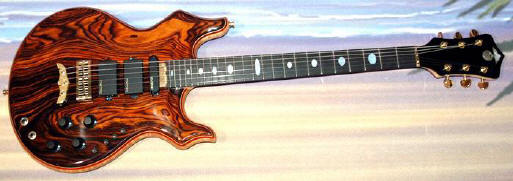 Cocobolo is an attractive, colorful wood with an interesting grain. Due to its lower density it offers a smooth, mellow sound with plenty of warmth. Cocobolo is an extremely dense (it doesn't float!) hardwood from South America. The wood has a natural, oily finish. It requires no finish coat of varnish, shellac or any kind of sealer. Cocobolo does not soak up water readily, and therefore does not swell when wet. Nor does it change size appreciably due to variations in temperature. It's easy to see why the physical properties of Cocobolo make it ideal for duck and goose call stoppers. Often a call can have a barrel made from other woods; the stopper is usually Cocobolo on a fine call. Other woods, such as rosewood, cherry and diamond wood, to name a few, work well as call stoppers - as do modern synthetics. Call barrels can be made from anything, plastic or wood - walnut, bois d' arc, even cedar. It's the stopper that determines the sound of the call.
We use Cocobolo for all of our fretless basses because of the extreme durability and long life of this wood. Its natural hardness and oiliness keep it from developing the grooves common to other fingerboard woods. We get it from Mexico and have sold it mostly for Laminate Body Tops. Orange Cocobolo is a beautifully colored hardwood, much like ebony, but with a lot of orange, gold, and tones of brown in it. From Central America: Mexico, Nicaragua, and Panama.
Common uses include cabinets, chessmen, inlay work, furniture, cutlery
handles, and ornamental work. Streaks of dark maroon, black, purple and red brown. There are roughly a dozen species of true rose woods in the world. (Yes, they smell like roses when cut with a saw.) A partial list would include Tulip wood, King wood, Cocobolo, East Indian Rose wood, and Brazilian Rose wood. With the exception of the latter, these are oily to the point of being dead in the tone department. So what is the point in coveting these materials when there are sonic superiors available? The problem is that in the public mind, rose wood is cool, so it has long been over harvested. Because of this Brazilian Rose wood has been banned from importation to the United States for over twenty five years. I think Brazilian Rosewood is over rated and overpriced and I would classify it as just another Scam Wood. Cocobolo doesn't cost as much and in many cases is cosmetically prettier Ed Roman
|

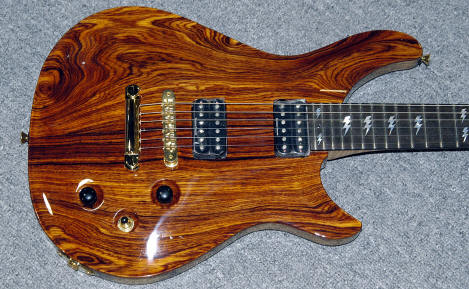
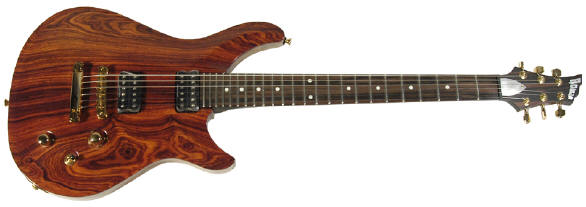
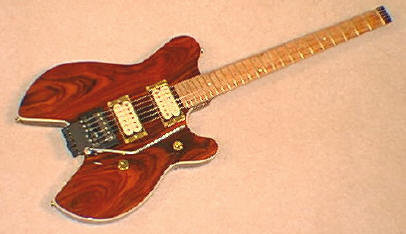
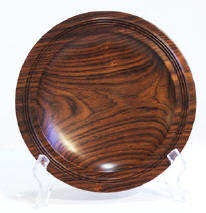 Cocobolo is in the Leguminosae Family and grows mostly in the Pacific
regions of Central America extending from Panama to southwestern Mexico. Of
limited occurrence, usually in the drier uplands. Somewhat variable in
color, deep rich orange-red with black striping or mottling on exposure to
air. Fine grain, straight to interlocked; oily; Basic specific gravity
>0.98. Cocobolo is denser and stronger than Brazilian Rosewood. It has
excellent drying properties, free of surface and end checking. Shrinkage is
usually low; high stability in use. Very low moisture absorption. Cocobolo
has excellent machining characteristics; natural oils give the wood a good
polish.
Cocobolo is in the Leguminosae Family and grows mostly in the Pacific
regions of Central America extending from Panama to southwestern Mexico. Of
limited occurrence, usually in the drier uplands. Somewhat variable in
color, deep rich orange-red with black striping or mottling on exposure to
air. Fine grain, straight to interlocked; oily; Basic specific gravity
>0.98. Cocobolo is denser and stronger than Brazilian Rosewood. It has
excellent drying properties, free of surface and end checking. Shrinkage is
usually low; high stability in use. Very low moisture absorption. Cocobolo
has excellent machining characteristics; natural oils give the wood a good
polish. Color varies from orange to deep red with irregular patterns of purple or
black. Grain is usually straight and fine textured. Contains a high oil
content, which acts as a barrier to water absorption and imparts a waxy
appearance when rubbed.
Color varies from orange to deep red with irregular patterns of purple or
black. Grain is usually straight and fine textured. Contains a high oil
content, which acts as a barrier to water absorption and imparts a waxy
appearance when rubbed.